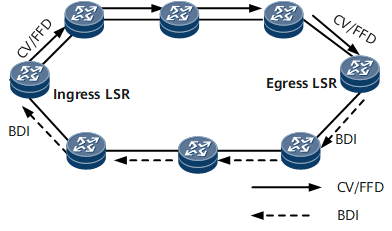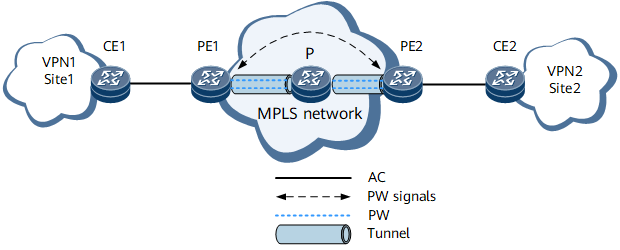Basic Detection
Background
The Multiprotocol Label Switching (MPLS) operation, administration and maintenance (OAM) mechanism effectively detects and locates MPLS link faults. The MPLS OAM mechanism also triggers a protection switchover after detecting a fault.
Related Concepts
- MPLS OAM packets
Table 1 describes MPLS OAM packets.
Table 1 MPLS OAM packets Packet Type
Description
Continuity check
Connectivity verification (CV) packet
Sent by a local MEP to detect exceptions. If the local MEP detects an exception, it sends an alarm to its client-layer MEP. For example, if a CV-enabled device receives a packet on an incorrect LSP, the device will report an alarm indicating a forwarding error to the client-layer MEP.
Fast failure detection (FFD) packet
Sent by a maintenance association end point (MEP) to rapidly detect an LSP fault. If the MEP detects a fault, it sends an alarm to the client layer.
NOTE:- FFD and CV packets contain the same information and provide the same function. They are processed in the same way, whereas FFD packets are processed more quickly than CV packets.
- FFD and CV cannot be started simultaneously.
Backward defect indication (BDI) packet
Sent by the egress to notify the ingress of an LSP defect.
- Channel defects
Table 2 describes channel defects that MPLS OAM can detect.
Table 2 Channel defect detection using MPLS OAM Defect Type
Description
MPLS layer defects
dLOCV: a connectivity verification loss defect.
A dLOCV defect occurs if no CV or FFD packets are received after three consecutive intervals at which CV or FFD packets are sent elapse.
dTTSI_Mismatch: a trail termination source identifier (TTSI) mismatch defect.
A dTTSI_Mismatch defect occurs if no CV or FFD packets with correct TTSIs are received after three consecutive intervals at which CV or FFD packets are sent elapse.
dTTSI_Mismerge: a TTSI mis-merging defect.
A dTTSI_Mismerge defect occurs if CV or FFD packets with both correct and incorrect TTSIs are received within three consecutive intervals at which CV or FFD packets are sent.
dExcess: an excessive rate at which connectivity detection packets are received.
A dExcess defect occurs if five or more correct CV or FFD packets are received within three consecutive intervals at which CV or FFD packets are sent.
Other defects
Oamfail: The OAM auto protocol expires.
An Oamfail defect occurs if the first OAM packet is not received after the auto protocol expires.
Signal deterioration (SD)
An SD defect occurs if the packet loss ratio reaches the configured SD threshold.
Signal failure (SF)
An SF defect occurs if the packet loss ratio reaches the configured SF threshold.
dUnknown: an unknown defect on an MPLS network.
A test packet type or interval inconsistency occurs between the source and sink nodes.
- Reverse tunnel
A reverse tunnel is bound to an LSP that is monitored using MPLS OAM. The reverse tunnel can transmit BDI packets to notify the ingress of an LSP defect. A reverse tunnel and the LSP to which the reverse tunnel is bound must have the same endpoints, and they transmit traffic in opposite directions. The reverse tunnels transmitting BDI packets include private or shared LSPs. Table 3 lists the two types of reverse tunnel.
Table 3 MPLS OAM reverse tunnel types type
Description
Private reverse LSP
Bound to only one LSP. The binding between the private reverse LSP and its forward LSP is stable but may waste LSP resources.
Shared reverse LSP
Bound to many LSPs. A TTSI carried in a BDI packet identifies a specific forward LSP bound to a reverse LSP. The binding between a shared reverse LSP and multiple forward LSPs minimizes LSP resource wastes. If defects occur on multiple LSPs bound to the shared reverse LSP, the reverse LSP may be congested with traffic.
Implementation
MPLS OAM periodically sends CV or FFD packets to monitor TE LSPs, PWs, or ring networks.
- MPLS OAM for TE LSPs
MPLS OAM monitors TE LSPs. If MPLS OAM detects a fault in a TE LSP, it triggers a traffic switchover to minimize traffic loss.
Figure 1 illustrates a network on which MPLS OAM monitors TE LSP connectivity. The process of using MPLS OAM to monitor TE LSP connectivity is as follows:
The ingress sends a CV or FFD packet along a TE LSP to be monitored. The packet passes through the TE LSP and arrives at the egress.
The egress compares the packet type, frequency, and TTSI in the received packet with the locally configured values to verify the packet. In addition, the egress collects the number of correct and incorrect packets within a detection interval.
If the egress detects an LSP defect, the egress analyzes the defect type and sends a BDI packet carrying defect information to the ingress along a reverse tunnel. The ingress can then be notified of the defect. If a protection group is configured, the ingress switches traffic to a backup LSP.
- MPLS OAM for PWs
MPLS OAM periodically sends CV or FFD packets to monitor PW connectivity. If MPLS OAM detects a PW defect, it sends BDI packets carrying the defect type along a reverse tunnel and instructs a client-layer application to switch traffic from the active link to the standby link.
Figure 2 illustrates a network on which MPLS OAM monitors PW connectivity.- For PE1 and PE2, a PW is established between them, OAM parameters are set on them, and they are enabled to send and receive OAM packets. OAM monitors the PW between PE1 and PE2 and obtains PW information
- If OAM detects a default, PE2 sends a BDI packet to PE1 over a reverse tunnel.
- PEs notify CEs of the fault so that CE1 and CE2 can use the information to maintain networks.

